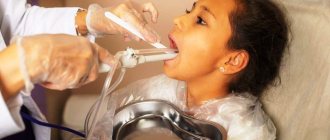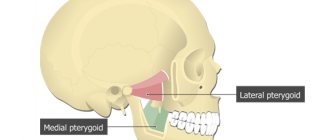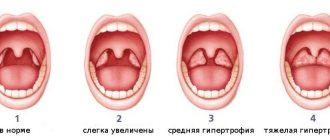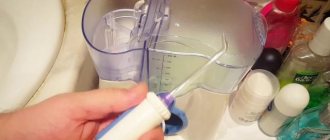The development of inflammatory pathologies of the palatine tonsils is often accompanied by the formation of purulent-caseous plugs in the recesses of accumulations of lymphoid tissue. As the disease progresses, the cheesy deposits thicken, enlarge and begin to cause discomfort. Rinsing the lacunae of the tonsils is the optimal method of conservative treatment that removes plugs
.
Is it possible to wash tonsils with an irrigator?
In this article
- Is it possible to wash tonsils with an irrigator?
- Why rinse your tonsils?
- Is it possible to rinse tonsils with an irrigator?
- Flushing the tonsils with an irrigator
- How to rinse tonsils at home with an irrigator
- When is tonsil flushing contraindicated?
- Basic recommendations: how to properly rinse tonsils at home
First, a few words about tonsils and tonsillitis. The human throat provides ideal conditions for the proliferation of fungi, viruses and bacteria. Tonsils (tonsils) protect the respiratory system from pathogenic microorganisms. They have microscopic lacunae into which food debris, dead epithelial cells and microbes fall. Tonsils are an important part of the body's immune system; they protect the lungs from infectious diseases, but at the same time become vulnerable to disease. A viral or bacterial inflammatory process in the lacunae of the tonsils causes chronic tonsillitis - a long-term inflammatory process of the pharyngeal or palatine tonsils.
This pathology can cause a person many problems, causing bad breath, fatigue, pain and sore throat. In addition, tonsillitis can cause tonsillitis and other complications. Treatment of this disease is carried out by an otolaryngologist. He prescribes a course of antibiotics and drugs for washing the tonsils.
Remove or treat?
Among experienced patients, there are many stories from the series: “Previously, the problem was solved simply - you just need to remove the tonsils, and life will sparkle with bright colors.” Many patients purposefully come to an ENT doctor with a request to get rid of tonsils once and for all. However, many do not understand that by removing such an important organ of the immune system, a person is deprived of a natural barrier against infection. Yes, the problem of tonsillitis will disappear, but other diseases, for example, of the respiratory tract, will take their place. Bacteria and viruses will be able to freely enter the body, causing inflammation of other human organs and systems.
To remove tonsils according to indications, you need:
- often have a sore throat (more than four times a year);
- have a history of peritonsillar abscess;
- have poor rheumatic test scores;
- diagnose complications in your heart, kidneys or joints.
If there are no direct indications for removal, you need to contact an otolaryngologist to prescribe competent complex therapy, which will significantly increase the duration of remission and reduce the number of exacerbations.
One of the most effective procedures for treating tonsillitis, which avoids removal, is washing the palatine tonsils.
Why rinse your tonsils?
Washing of the tonsils is carried out taking into account the characteristics of this organ. The tonsils are a collection of lymphoid tissue, inside of which there are small cavities and passages. They quickly fill with food debris, saliva and plaque from the teeth, which subsequently cause tonsillitis. Its manifestations can be minimized by washing the tonsils. You should contact an ENT specialist, who will prepare an antibacterial solution and carry out the procedure with a syringe or irrigator. Doing this yourself at home is dangerous, it can damage the tissue and cause complications.
The doctor may prescribe a course of physiotherapeutic procedures, the duration of which is 5-10 sessions - it all depends on the degree of the disease. When washing the tonsils, foreign substances and pus are removed from the lacunae. After several procedures, the process of self-cleaning of the tonsils begins. To avoid injury to the tonsils during tonsillitis, they can only be washed in the otolaryngologist’s office. Rinsing for the purpose of prevention is carried out at home using oral irrigators.
Rinsing with a modified Tonsillor nozzle
This method of washing will not be offered to you in any of the clinics in Moscow, except for the ENT Clinic of Doctor Zaitsev! An improved, modified attachment for the Tonsillor apparatus was developed by the founder of the ENT clinic, Vladimir Mikhailovich Zaitsev, together with his colleagues. The operating principle of the new nozzle is absolutely the same as that of the classic nozzle. The difference is in its structure:
- the improved “Tonsillor” nozzle creates greater negative pressure, due to which rinsing the tonsils is much more effective and of better quality;
- the edges of the nozzle in contact with the tonsils do not cause damage or microtrauma;
- The cup of the nozzle into which the washing solution with the purulent contents of the lacunae is sucked in is transparent, and the doctor immediately sees at what point the procedure can be stopped. Thus, the patient does not undergo unnecessary manipulations.
- The size of the nozzle allows washing even for children.
It is necessary to rinse the tonsils only with the participation of an otolaryngologist. We do not recommend self-medication!
In order to forget about the symptoms of chronic tonsillitis for a long time, it is necessary to undergo a full comprehensive course of treatment of chronic inflammation, including, in addition to rinsing, drug therapy and physiotherapeutic procedures. This is the only way to preserve the tonsils and achieve stable remission!
Is it possible to rinse tonsils with an irrigator?
An oral irrigator is a device that, by supplying pulsating water, cleanses the teeth and gums of food debris. According to dentists, regular use of such devices helps prevent the development of caries, gingivitis, periodontitis and other dental diseases. The irrigator should be used as an additional hygiene product, along with a toothbrush and floss. You need to use it at least 2-3 times a week, and better yet, every evening after traditional teeth brushing.
Modern irrigators are multifunctional devices that are suitable for cleansing the oral cavity, massaging the gums and rinsing the tonsils. The device reservoir should be filled with plain water or a disinfectant solution, furatsilin and other products approved by a doctor and compatible with a specific device. Let's learn how to wash your tonsils at home using an irrigator.
Schemes for preparing antiseptic solutions
Self-production of Furacilin, medicinal decoctions, saline solution and a number of other disinfecting liquids is allowed. Cooking methods are listed in the table below.
| Solution | Way | Proportions |
| Saline | Sea or table salt is combined with warm water. | 1 teaspoon of substance per 200 ml of liquid |
| Furacilin | The drug tablet dissolves in boiled water; the solution is infused for up to half an hour. | 2 pills per glass of water |
| Chlorophylliptate | The medicine is mixed with water. | 1 part drug to 5 parts liquid |
| From propolis | The alcohol (aqueous) tincture is diluted with water. | Alcohol: 1 tsp. medical product for half a glass of liquid. Water: 1:3 |
| From medicinal herbs | Medicinal infusions (oak bark, sage, chamomile, calendula) are poured with boiling water, infused for 30 minutes, and filtered. | 1 tablespoon per 200 ml of boiling water. |
When using solutions for the treatment procedure, you must remember the main rule: if you have an individual intolerance to the components of the product (this is often manifested by allergic reactions), the use of disinfectant liquids is prohibited.
Flushing the tonsils with an irrigator
First you need to choose a suitable irrigator model. It can be portable or stationary, pulsed or microbubble. Portable models are not suitable for washing tonsils, as they have one significant drawback - the inability to smoothly switch the water supply mode. A sudden change in pressure and jet pressure can lead to tissue injury. Therefore, it is better to choose stationary models for washing the tonsils.
They are more functional and have several operating modes, including for cleaning gums and tonsils. In addition, stationary irrigators come with several nozzles, while portable ones are sold with one, or maximum two nozzles.
The minimum value of the cleaning jet pressure created by an irrigator suitable for washing tonsils should not be more than 150 kPa. Waterpik WP-108 E2 Ultra is ideal for this procedure - a stationary device that supplies pressure from 70 to 560 kPa. There is a lever on the handle for smooth switching of modes. You need to start the procedure with the weakest pressure, gradually increasing it. The device comes complete with 7 attachments. One of them is designed to clean gum pockets. It can also be used to wash the tonsils. Two standard attachments are also suitable for this.
Another suitable irrigator that can be used to wash tonsils is available under the brand name Aquapick AQ-300. It has several operating modes and 4 attachments included. The reservoir is quite large - 600 ml. It is enough for a complete cleaning for two or three family members. This device can be mounted on the bathroom wall using a bracket. It is not cheap, but it is one of the most functional. There is also a more budget option - B.Well WI-922. This device can be used to clear tonsils, but the minimum power it produces is 200 kPa. This irrigator is not suitable for children to wash their tonsils.
Our online store offers many stationary irrigators that can be used for washing tonsils. When purchasing, consider the following indicators: jet power, minimum pressure, number of operating modes, pulsation frequency and tank volume. Now we’ll find out how to rinse your tonsils with an irrigator at home.
Washing of the palatine tonsils in a clinical setting
Moscow clinics offer patients 2 highly effective options for hardware cleaning of the tonsils:
- vacuum, using the Tonsilor device;
- deep washing, combining hardware cleaning with phonophoresis and ultrasound.
Both methods help not only to cure the acute stages of ENT diseases, but also to get rid of chronic tonsillitis.
Vacuum rinsing of tonsils
The hardware method of cleansing the tonsils is a procedure that brings discomfort to the patient. To reduce pain, an anesthetic is used (usually the drug Lidocaine).
The duration of the manipulations is up to 10 minutes.
The procedure flow is as follows:
- the patient is asked to take a sitting position, tilt his head down, stick out his tongue;
- a special device with which the device is equipped is applied to the patient’s lymphoid accumulations;
- Using a vacuum, purulent deposits are removed from the ducts.
The course of therapy usually includes up to 10 rinses (in difficult cases, treatment is extended for another 5 procedures). After recovery, to achieve a prolonged effect, experts recommend repeating the vacuum cleansing procedure after 12 months.
You can see how the treatment procedure occurs in the video:
Contraindications to the use of this method in treatment regimens are: pregnancy, oncopathologies, retinal detachment, atherosclerosis, pulmonary tuberculosis.
Ultrasonic exposure
Excellent results in the treatment of tonsillitis are shown by deep cleansing of lymphoid accumulations. The liquefaction of purulent accumulations and the death of pathogens is caused by ultrasound (frequency - 26.5 kHz). The process is complemented by the introduction of medicinal drugs into the lymphoid tissue (phonophoresis). Before carrying out the procedure, you should watch a video about the main stages of Tonsilor therapy:
Timely treatment of inflammatory diseases of the ENT organs significantly reduces the risk of pathologies. An integrated approach will allow you to completely get rid of problems
- not only washing, but also taking drugs that stabilize the immune system, as well as hardening.
How to rinse tonsils at home with an irrigator
It is better to rinse the tonsils on an empty stomach in the morning, since a stream of water entering the larynx can cause vomiting. Such reflexes cease to bother you after regular procedures. The duration of rinsing the tonsils is 2-3 minutes, but you can start from 30-40 seconds until slight discomfort appears in the throat. Washing is performed according to the following algorithm:
- stand in front of the mirror and take the irrigator handle;
- set the jet pressure to the minimum level;
- insert the tip of the device into your mouth and turn on the device;
- When changing the position of the device, turn it off each time.
Before washing, make sure the device is in working order. Fill the reservoir with a suitable solution.
Do not use decoctions and infusions. The smallest plant particles included in them can become clogged in the device’s filter and damage it.
After the procedure, you need to thoroughly clean the nozzle and put it in the case. When washing, do not swallow the solution, as it contains microbes washed out of the lacunae of the glands. Do not tilt your head back to prevent liquid from entering your respiratory tract.
After the procedure, you may feel dry mouth and sore throat. This is a normal reaction of the body to the solution used and the pulsation of the liquid. Subsequently, the larynx will get used to the effects of pulsating water. However, if you experience a sore throat and blood in your saliva, stop using the irrigator and consult a doctor. At home, only preventive cleaning of the tonsils is possible. For tonsillitis, you need to undergo the procedure in the ENT office.
Vacuum method
To carry out the manipulation, an ultrasonic device “Tonsillor” is used. As standard, the device comes with a vacuum nozzle for washing gland lacunae. At the beginning of the manipulation, the ENT doctor performs topical anesthesia of the palatine tonsils with a solution of Lidocaine. The patient sits comfortably in a chair and opens his mouth.
The vacuum nozzle is brought to the surface of the tonsils and attached to it. The washing solution is fed through a nozzle, passes through the gaps and, under pressure, washes out all the pathogenic contents from them. Antiseptic or saline solutions are used as flushing solutions. The solution passes through the thickness of the tonsil once and is not reused, since after washing it is removed into a special suction.
Since the waste solution goes directly into the suction, infection of healthy tissues during the manipulation is excluded.
The procedure is carried out under the influence of ultrasonic vibrations, which allows the medicine to penetrate deeper layers of tissue, and this contributes to a rapid recovery.
In general, the procedure on the Tonsillor apparatus resembles the principle of operation of a vacuum cleaner. This vacuum sanitation allows you to effectively clean the lacunae of the tonsils and get rid of purulent accumulations.
On average, five to ten sessions are required to achieve a lasting therapeutic effect.
At this point we could put a full stop and end the article. But there is another way to carry out vacuum rinsing - using a modified attachment of the Tonsillor device, which is used only in the ENT Clinic of Doctor Zaitsev.
When is tonsil flushing contraindicated?
The procedure is not recommended for people with arterial hypertension - there is a risk of a sharp increase in blood pressure. Also among the contraindications:
- acute infectious diseases of the gums, teeth and throat;
- increased body temperature;
- retinal pathologies and glaucoma;
- severe heart failure;
- 1st and 3rd trimesters of pregnancy;
- allergy to solutions used for rinsing.
Do not use faulty appliances. An irrigator can damage your gums and tonsils if the jet pressure is too strong. If the device does not work well, replace it.
Basic recommendations: how to properly rinse tonsils at home
Experts advise adhering to the following rules when washing your tonsils:
- choose only high-quality irrigators with several operating modes and the ability to regulate pressure;
- wash your tonsils to prevent tonsillitis if it has already been diagnosed once;
- carry out the procedure in courses of 5-10 procedures with intervals of several months;
- during the period of preventive treatment, avoid spicy and hard foods (crackers, chips, etc.), which can burn or scratch the larynx;
- After rinsing, gargle with an antiseptic solution.









